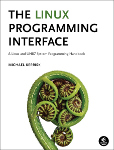| HTML rendering created 2025-09-06 by Michael Kerrisk, author of The Linux Programming Interface. For details of in-depth Linux/UNIX system programming training courses that I teach, look here. Hosting by jambit GmbH. |  |
| NAME | SYNOPSIS | DESCRIPTION | THEORY | 2.6 KERNELS | OPTIONS | BUGS | SEE ALSO | COLOPHON | |
| |
SETKEYCODES(8) System Manager's Manual SETKEYCODES(8) setkeycodes - load kernel scancode-to-keycode mapping table entries
setkeycodes [options] scancode keycode ...
The setkeycodes command reads its arguments two at a time, each pair of arguments consisting of a scancode (given in hexadecimal) and a keycode (given in decimal). For each such pair, it tells the kernel keyboard driver to map the specified scancode to the specified keycode. This command is useful only for people with slightly unusual keyboards, that have a few keys which produce scancodes that the kernel does not recognize.
The usual PC keyboard produces a series of scancodes for each key press and key release. (Scancodes are shown by showkey -s, see showkey(1) ) The kernel parses this stream of scancodes, and converts it to a stream of keycodes (key press/release events). (Keycodes are shown by showkey.) Apart from a few scancodes with special meaning, and apart from the sequence produced by the Pause key, and apart from shiftstate related scancodes, and apart from the key up/down bit, the stream of scancodes consists of unescaped scancodes xx (7 bits) and escaped scancodes e0 xx (8+7 bits). To these scancodes or scancode pairs, a corresponding keycode can be assigned (in the range 1-127). For example, if you have a Macro key that produces e0 6f according to showkey(1), the command setkeycodes e06f 112 will assign the keycode 112 to it, and then loadkeys(1) can be used to define the function of this key. Some older kernels might hardwire a low scancode range to the equivalent keycodes; setkeycodes will fail when you try to remap these.
In 2.6 kernels key codes lie in the range 1-255, instead of 1-127. (It might be best to confine oneself to the range 1-239.) In 2.6 kernels raw mode, or scancode mode, is not very raw at all. The code returned by showkey -s will change after use of setkeycodes. A kernel bug. See also showkey(1).
-C, --console=DEV the console device to be used. -V, --version print version number. -h, --help print this usage message.
The keycodes of X have nothing to do with those of Linux. Unusual keys can be made visible under Linux, but not under X.
dumpkeys(1), loadkeys(1), showkey(1), getkeycodes(8)
This page is part of the kbd (Linux keyboard tools) project. Information about the project can be found at ⟨http://www.kbd-project.org/⟩. If you have a bug report for this manual page, send it to kbd@lists.altlinux.org. This page was obtained from the project's upstream Git repository ⟨https://github.com/legionus/kbd.git⟩ on 2025-08-11. (At that time, the date of the most recent commit that was found in the repository was 2025-07-01.) If you discover any rendering problems in this HTML version of the page, or you believe there is a better or more up-to-date source for the page, or you have corrections or improvements to the information in this COLOPHON (which is not part of the original manual page), send a mail to man-pages@man7.org kbd 24 October 2024 SETKEYCODES(8) Pages that refer to this page: showkey(1), getkeycodes(8)